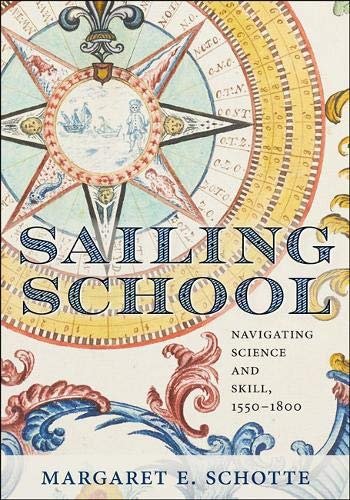Sailing School: Navigating Science and Skill, 1550-1800
Margaret E. Schotte
 The question of how one becomes a proficient sailor has long been a subject of debate and speculation within maritime history. At what point does a green hand become and able seaman? Which skills were considered essential in an era before state-regulated licensing? Navigators were among the earliest class of seaman to undergo regulatory exams which assessed their knowledge, skills, and preparedness to undertake the critical task of guiding ships from one safe harbor to the next. This professionalization and regulation of navigators’ skills resulted in a body of texts, manuals, workbooks, and logbooks which give insight into how these skills were taught, practiced, and retained by practitioners.
The question of how one becomes a proficient sailor has long been a subject of debate and speculation within maritime history. At what point does a green hand become and able seaman? Which skills were considered essential in an era before state-regulated licensing? Navigators were among the earliest class of seaman to undergo regulatory exams which assessed their knowledge, skills, and preparedness to undertake the critical task of guiding ships from one safe harbor to the next. This professionalization and regulation of navigators’ skills resulted in a body of texts, manuals, workbooks, and logbooks which give insight into how these skills were taught, practiced, and retained by practitioners.
As sailing routes rapidly expanded in the early modern period, so too did the skills and techniques that a navigator was required to understand. ‘Small’ coastal navigation was increasingly augmented with the need for ‘large’ transoceanic navigational techniques. Coastal pilots memorized coastlines, tides, and counted moon phases on their knuckles, and were largely trained through shipboard experience. However, increasing mathematization of the craft required that transoceanic navigators master trigonometry, memorize formulas, and adapt to new instruments by which to measure their position on the globe.
In this book, Schotte adapts her dissertation into a detailed, transnational study of how navigators were trained, evaluated, and the texts and tools they employed along the way. Schotte mines archives throughout Europe, particularly Spain, The Netherlands, France, and England. Using textual and content analysis approach, she outlines which techniques and skills were most favored by different nations throughout time. What emerges is a strikingly similar trajectory in the techniques used by navigators throughout Europe, even though the timeline of adoption and the emphasis of topics differed from nation to nation. This study reveals how the proliferation of print and literacy improved the training of navigators until it was an essential skill. Despite the growth in classroom learning, the need for practical, shipboard experience was crucial. Nations often struggled to find the right balance of book learning and shipboard experience, and this ‘pendulum’ often swung back and forth throughout the period and according to the priorities of each locale.
The work is thoroughly researched, analyzed, and includes a multitude of descriptive end notes and citations. Schotte frequently includes passages of narrative description, illustrations, engravings, diagrams, and images from manuscripts which help break up and bring clarity to heavily technical sections. Admittedly, the nuance of Euclidian geometry, trigonometry, and logarithms as applied to navigation may be a bit lost on readers with a soft grounding in mathematics. However, Schotte does an admirable job explaining the principles of such technical skills, and how navigators applied that information to solve navigational problems both in the classroom and on the decks of their ships. There is surprisingly limited discussion of the chronometer its effect on navigational practice. However, this omission is understandable when recognizing that the technology came into use towards the end of the period, and that the topic has been covered at length in other volumes. The final chapter narrates how one English navigator, Edward Riou, was able to steer a foundering vessel to safety despite challenging weather conditions and a missing rudder. This chapter beautifully encapsulates how proficient navigators were required to balance technical and practical skills and be well versed in a variety of navigational techniques, both old and new, in order to solve problems at sea.
Overall, Sailing School is and extremely informative look into the practice and transmission of navigational knowledge in Europe during the scientific revolution, and how text helped to codify and communicate that information to new practitioners.
- Baltimore: Johns Hopkins University Press, 2019
- 7-1/4” x 10-1/4”, hardcover, xi + 297 pages
- Illustrations, glossary, notes, bibliography, index. $59.95
- ISBN: 9781421429533
Reviewed by Kendra Lawrence, East Carolina University
